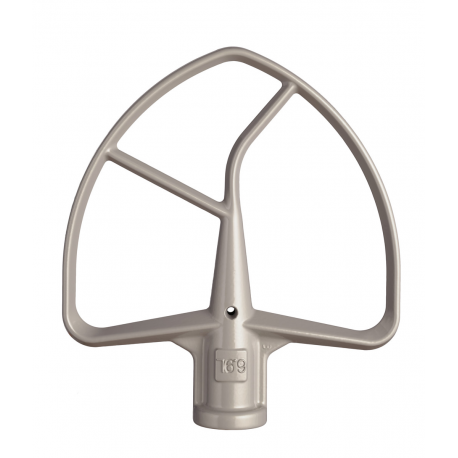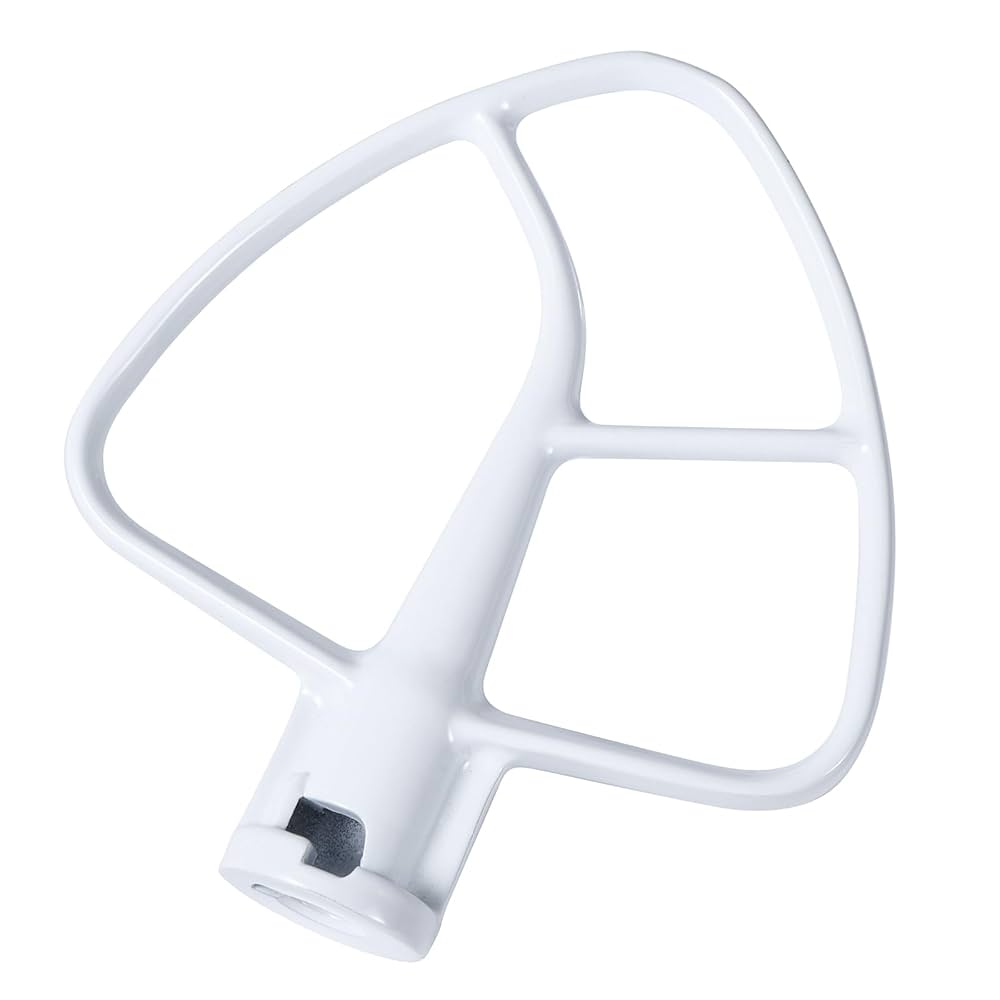Have you ever wondered about the different attachments that come with your mixer? Among them, the flat beater stands out as a true kitchen hero.
But what exactly is a flat beater on a mixer, and why should you care? Imagine achieving the perfect cake batter or cookie dough every time you bake. The secret might just lie in this versatile tool. In this blog, we’ll unravel the mysteries of the flat beater, showing you how it can revolutionize your cooking and baking experiences.
Stay with us to discover how this simple attachment can transform your kitchen creations from ordinary to extraordinary. You won’t want to miss the insights that could elevate your culinary skills to new heights.

Credit: www.amazon.ca
Flat Beater Basics
The flat beater is a common attachment for stand mixers. It works well for mixing many everyday ingredients.
This tool helps combine ingredients evenly without adding too much air. It is a must-have for many kitchen tasks.
Design And Material
The flat beater usually has a flat, paddle-like shape. It fits into the mixer and spins to mix ingredients.
| Material | Common Use | Benefits |
| Metal (usually stainless steel) | Heavy mixing tasks | Strong and durable, easy to clean |
| Plastic or coated metal | Light mixing tasks | Non-stick surface, gentle on bowls |
Common Uses In Baking
The flat beater is good for many baking jobs. It mixes batters and doughs without overworking them.
- Mixing cake batters and cookie dough
- Blending frostings and fillings
- Mixing mashed potatoes or other soft foods
- Combining ingredients for quick breads

Credit: kitchen.eu
Types Of Flat Beaters
A flat beater is a common mixer attachment. It helps mix ingredients evenly and quickly.
There are different types of flat beaters. Each type fits specific mixing tasks.
Standard Flat Beaters
Standard flat beaters work for most everyday mixing jobs. They are great for batters and doughs.
These beaters blend ingredients smoothly without adding too much air. They are strong and durable.
Paddle Beaters With Scrapers
Paddle beaters with scrapers have flexible edges. These edges scrape the sides of the bowl while mixing.
This type prevents ingredients from sticking to the bowl. It improves mixing without stopping to scrape by hand.
- Helps mix thick batters
- Reduces manual scraping
- Good for sticky doughs
Specialty Flat Beaters
Specialty flat beaters are designed for unique mixing needs. They handle specific tasks better than standard beaters.
Examples include beaters for heavy dough, whipping, or delicate mixtures. These beaters have special shapes or materials.
- Heavy-duty beaters for thick dough
- Whipping beaters for light mixtures
- Non-stick coated beaters for easy cleaning
How Flat Beaters Work
The flat beater is a common mixer attachment. It is used for mixing medium-density foods. Examples include cake batter, cookie dough, and mashed potatoes.
This beater moves ingredients in a circular motion. It mixes without adding too much air. This helps keep the texture smooth and even.
Mixing Technique
The flat beater stirs ingredients by scraping the bowl’s sides. It moves food from the edges to the center. This ensures all parts mix well.
- Use the flat beater for batters and doughs that are not too thick.
- Start mixing at low speed to avoid splashing.
- Scrape the bowl if needed to mix all ingredients evenly.
- Stop mixing as soon as ingredients combine to prevent overmixing.
Speed Settings And Effects
The mixer speed changes how the flat beater works. Low speeds mix gently. High speeds mix faster but can add air.
| Speed Setting | Effect on Mixing |
|---|---|
| Low | Combines ingredients slowly without splashing |
| Medium | Mixes ingredients thoroughly and evenly |
| High | Adds air for lighter textures but may cause splatter |

Credit: www.mrmixer.store
Choosing The Right Flat Beater
A flat beater is a common mixer attachment. It helps mix ingredients evenly and quickly.
Choosing the right flat beater is important for good mixing results. It depends on your mixer and recipe.
Matching With Mixer Models
Flat beaters come in different sizes and shapes. Not all beaters fit every mixer model.
Check your mixer brand and model before buying a flat beater. This ensures proper fit and performance.
- Look for beaters made for your mixer brand
- Match the beater size to your mixer’s capacity
- Use original or approved accessories for best results
Considering Recipe Requirements
Different recipes need different flat beater types. Some beaters work better with thick doughs, others with light batters.
Choose a flat beater that suits the texture and mixing speed your recipe needs.
- Use heavy-duty beaters for cookie dough or thick mixtures
- Light flat beaters are good for cake batter and frosting
- Check if your recipe needs a special attachment for best mixing
Care And Maintenance
A flat beater is a common attachment for stand mixers. It helps mix many ingredients evenly. Taking care of your flat beater keeps it working well for a long time.
Cleaning and storing the flat beater properly stops damage and keeps it safe from rust or dirt.
Cleaning Tips
Clean the flat beater right after use. This stops food from hardening on it. Use warm water and mild soap for washing. Avoid harsh chemicals that can damage the finish.
Use a soft sponge or cloth to clean all surfaces. Check holes or crevices where food can hide. Dry the beater completely before storing it to prevent rust.
- Rinse off loose food with warm water
- Wash with gentle soap and soft sponge
- Use a brush for hard-to-reach spots
- Dry fully with a clean towel
- Avoid dishwasher if the manual warns against it
Storage And Handling
Store the flat beater in a dry place. Keep it away from heavy items that can bend or damage it. Hanging it or placing it in a safe drawer works well.
Handle the beater gently. Avoid dropping it or using it for tasks it is not made for. Proper handling extends the life of the beater and keeps it safe to use.
- Keep in a dry, clean spot
- Do not stack heavy items on top
- Hang or store flat in a drawer
- Use only for mixing tasks
- Check for damage before each use
Flat Beater Vs Other Attachments
The flat beater is a common mixer attachment. It mixes ingredients evenly and quickly. This tool works well for many recipes.
Other attachments like whisks and dough hooks have different uses. They handle specific tasks better than flat beaters.
Comparing With Whisks
Whisks add air into mixtures. They are great for light and fluffy results. Use whisks for whipping cream or egg whites.
Flat beaters do not add much air. They mix thick batters and doughs well. Flat beaters are better for heavy mixtures.
- Whisks: best for light, airy mixtures
- Flat beaters: best for thick, heavy batters
- Whisks speed up whipping processes
- Flat beaters mix ingredients without much air
Comparing With Dough Hooks
Dough hooks are designed to knead dough. They stretch and fold dough to develop gluten. Use dough hooks for bread and pizza dough.
Flat beaters mix dough gently but do not knead well. They work better for cookie dough or cake batter. Dough hooks handle thick, sticky doughs better.
- Dough hooks: knead and develop dough
- Flat beaters: mix but do not knead dough
- Dough hooks work well with sticky doughs
- Flat beaters are good for softer mixtures
Troubleshooting Common Issues
A flat beater is a common mixer attachment used for many recipes. It helps mix dough, batter, and other ingredients evenly.
Sometimes, users face problems with mixing or fitting the flat beater. This guide covers common issues and how to fix them.
Mixing Problems
The flat beater may not mix ingredients properly. This can cause uneven batter or dough.
Check if the beater spins freely and reaches all parts of the bowl. If not, the mixer speed or attachment might be the problem.
- Make sure the beater is attached tightly to the mixer.
- Use the right speed for your recipe.
- Check if the bowl is locked in place correctly.
- Clean the beater and bowl to remove stuck ingredients.
- If ingredients stick to the sides, scrape down the bowl during mixing.
Attachment Fit Issues
The flat beater may not fit well on the mixer hub. A loose or stuck beater causes problems.
Check for dirt or damage on the beater or hub. These can block a proper fit.
- Clean the attachment and hub regularly.
- Inspect the beater for cracks or bends.
- Align the beater’s notch with the mixer hub slot before attaching.
- Press the beater firmly until it clicks into place.
- If the beater still won’t fit, try another attachment to test the hub.
Frequently Asked Questions
What Is A Flat Beater On A Mixer Used For?
A flat beater mixes medium to heavy batters like cookie dough and cake batter. It ensures even blending without overmixing.
How Does A Flat Beater Differ From Other Mixer Attachments?
The flat beater is sturdier and ideal for dense mixtures. Unlike whisks, it doesn’t add air. It’s not as heavy-duty as dough hooks.
Can I Use A Flat Beater For Whipping Cream?
No, a flat beater is not suitable for whipping cream. Use a whisk attachment to incorporate air and create fluffy texture.
What Materials Are Flat Beaters Made From?
Flat beaters are typically made from metal, coated with non-stick or stainless steel. This makes cleaning easier and prevents food from sticking.
Conclusion
A flat beater is a useful tool for many mixing tasks. It works well with batters, doughs, and other ingredients. This attachment helps mix evenly and saves time in the kitchen. Knowing how to use it can improve your cooking results.
Try it next time you bake or prepare food. It makes mixing easier and more efficient. Simple, practical, and reliable. A great addition to your kitchen mixer.

